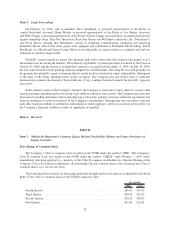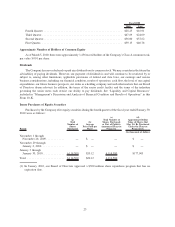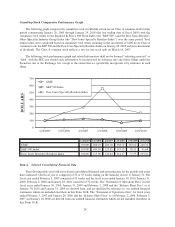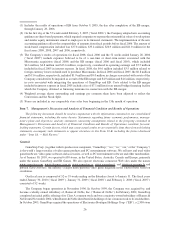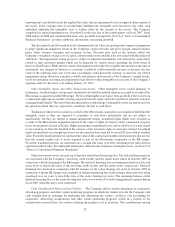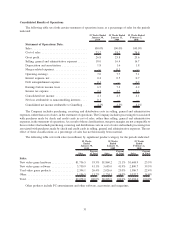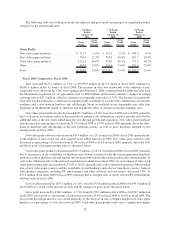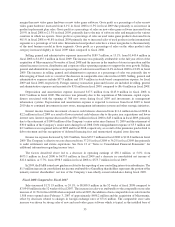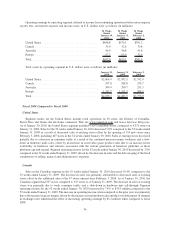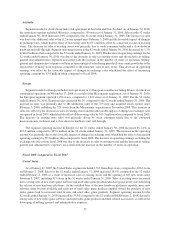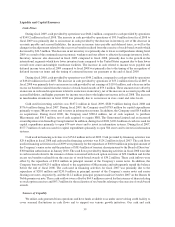GameStop 2009 Annual Report Download - page 45
Download and view the complete annual report
Please find page 45 of the 2009 GameStop annual report below. You can navigate through the pages in the report by either clicking on the pages listed below, or by using the keyword search tool below to find specific information within the annual report.as a reduction in inventory is recognized in cost of sales as inventory is sold. The amount of vendor allowances
recorded as a reduction of inventory is determined by calculating the ratio of vendor allowances in excess of
specific, incremental and identifiable advertising and promotional costs to merchandise purchases. The
Company then applies this ratio to the value of inventory in determining the amount of vendor reimbursements
recorded as a reduction to inventory reflected on the balance sheet. Because of the variability in the timing of
our advertising and marketing programs throughout the year, the Company uses significant estimates in
determining the amount of vendor allowances recorded as a reduction of inventory in interim periods,
including estimates of full year vendor allowances, specific, incremental and identifiable advertising and
promotional costs, merchandise purchases and value of inventory. Estimates of full year vendor allowances
and the value of inventory are dependent upon estimates of full year merchandise purchases. Determining the
amount of vendor allowances recorded as a reduction of inventory at the end of the fiscal year no longer
requires the use of estimates as all vendor allowances, specific, incremental and identifiable advertising and
promotional costs, merchandise purchases and value of inventory are known.
Although management considers its advertising and marketing programs to be effective, we do not
believe that we would be able to incur the same level of advertising expenditures if the vendors decreased or
discontinued their allowances. In addition, management believes that the Company’s revenues would be
adversely affected if its vendors decreased or discontinued their allowances, but management is unable to
quantify the impact.
Lease Accounting. The Company’s method of accounting for rent expense (and related deferred rent
liability) and leasehold improvements funded by landlord incentives for allowances under operating leases
(tenant improvement allowances) is in conformance with GAAP. For leases that contain predetermined fixed
escalations of the minimum rent, we recognize the related rent expense on a straight-line basis and include the
impact of escalating rents for periods in which we are reasonably assured of exercising lease options and we
include in the lease term any period during which the Company is not obligated to pay rent while the store is
being constructed, or “rent holiday.”
Income Taxes. The Company accounts for income taxes utilizing an asset and liability approach, and
deferred taxes are determined based on the estimated future tax effect of differences between the financial
reporting and tax bases of assets and liabilities using enacted tax rates. As a result of our operations in many
foreign countries, our global tax rate is derived from a combination of applicable tax rates in the various
jurisdictions in which we operate. We base our estimate of an annual effective tax rate at any given point in
time on a calculated mix of the tax rates applicable to our Company and to estimates of the amount of income to
be derived in any given jurisdiction. We file our tax returns based on our understanding of the appropriate tax
rules and regulations. However, complexities in the tax rules and our operations, as well as positions taken
publicly by the taxing authorities, may lead us to conclude that accruals for uncertain tax positions are
required. We generally maintain accruals for uncertain tax positions until examination of the tax year is
completed by the taxing authority, available review periods expire or additional facts and circumstances cause
us to change our assessment of the appropriate accrual amount.
In July 2006, the Financial Accounting Standards Board (“FASB”) issued accounting guidance that
clarified the accounting for uncertainty in income taxes recognized in an enterprise’s financial statements. This
guidance prescribes a recognition threshold and measurement attribute for the financial statement recognition
and measurement of a tax position taken or expected to be taken in a tax return. It also provides guidance on
derecognition, classification, interest and penalties, accounting in interim periods, disclosure and transition.
Our Company adopted the provisions of this accounting guidance and changed our accounting policy effective
on February 4, 2007. For additional information, see Note 12 of “Notes to Consolidated Financial Statements.”
30




